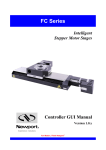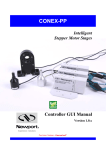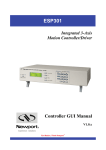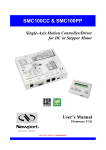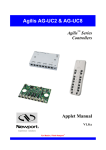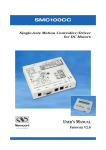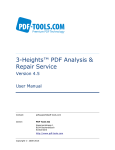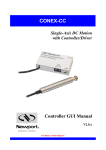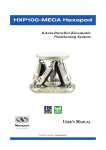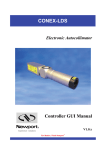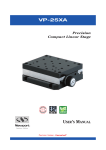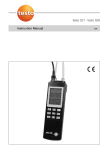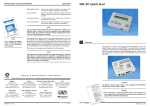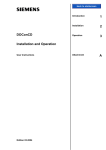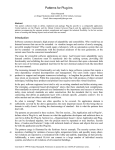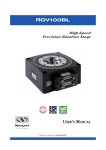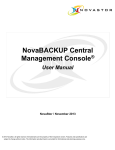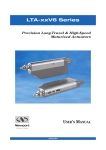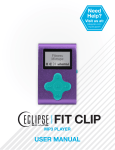Download SMC100 Controller GUI Manual
Transcript
SMC100CC & SMC100PP
Single-Axis Motion Controller/Driver
for DC or Stepper Motor
Controller GUI Manual
Version 1.0.x
For Motion, Think Newport
SMC100CC & SMC100PP
Controller GUI Manual
Preface
Confidentiality & Proprietary Rights
Reservation of Title
The Newport Programs and all materials furnished or produced in connection with them
("Related Materials") contain trade secrets of Newport and are for use only in the
manner expressly permitted. Newport claims and reserves all rights and benefits
afforded under law in the Programs provided by Newport Corporation.
Newport shall retain full ownership of Intellectual Property Rights in and to all
development, process, align or assembly technologies developed and other derivative
work that may be developed by Newport. Customer shall not challenge, or cause any
third party to challenge, the rights of Newport.
Preservation of Secrecy and Confidentiality and Restrictions to Access
Customer shall protect the Newport Programs and Related Materials as trade secrets of
Newport, and shall devote its best efforts to ensure that all its personnel protect the
Newport Programs as trade secrets of Newport Corporation. Customer shall not at any
time disclose Newport's trade secrets to any other person, firm, organization, or
employee that does not need (consistent with Customer's right of use hereunder) to
obtain access to the Newport Programs and Related Materials. These restrictions shall
not apply to information (1) generally known to the public or obtainable from public
sources; (2) readily apparent from the keyboard operations, visual display, or output
reports of the Programs; (3) previously in the possession of Customer or subsequently
developed or acquired without reliance on the Newport Programs; or (4) approved by
Newport for release without restriction.
©2013 Newport Corporation
1791 Deere Ave.
Irvine, CA 92606, USA
(949) 863-3144
EDH0310En1022 – 11/13
ii
SMC100CC & SMC100PP
Controller GUI Manual
Table of Contents
Preface ..............................................................................................................................ii
Confidentiality & Proprietary Rights ...............................................................ii
1.0
Introduction .................................................................................................. 1
1.1
Purpose .................................................................................................................................... 1
1.2
Overview ................................................................................................................................. 1
1.3
Controller State Diagram ......................................................................................................... 2
1.4
Building the System ................................................................................................................. 3
2.0
Getting Started .............................................................................................. 4
2.1
Discover Instruments ............................................................................................................... 4
3.0
User Interface ................................................................................................ 5
3.1
Configuration ........................................................................................................................... 5
3.2
Main ......................................................................................................................................... 7
3.3
Jog 9
3.4
GPIO ...................................................................................................................................... 10
3.5
Parameters ............................................................................................................................. 11
3.6
Address .................................................................................................................................. 13
3.6.1
Controller pool setting ....................................................................................... 14
3.6.2
Controller address setting................................................................................... 16
3.7
Diagnostics ............................................................................................................................ 17
3.8
About ..................................................................................................................................... 18
Service Form ........................................................................................................ 19
iii
EDH0310En1022 – 11/13
SMC100CC & SMC100PP
EDH0310En1022 – 11/13
Controller GUI Manual
iv
SMC100CC & SMC100PP
Controller GUI Manual
SMC100
Single-Axis Motion Controller
1.0
Introduction
EDH0310En1022 – 11/13
1.1
Purpose
The purpose of this document is to provide instructions on how to use the
SMC100 Controller GUI.
1.2
Overview
The SMC100 Controller GUI is a graphical user interface (GUI) which
allows the user to interact with the SMC100CC or SMC100PP controller
that is connected to stages. The user can initiate moves, change the state of
the controller, adjust parameters, etc.
1
SMC100CC & SMC100PP
Controller GUI Manual
1.3
Controller State Diagram
The SMC100 controller is defined by the following state diagram.
End of Runs encountered in the following state:
NOT REFERENCED: No action.
CONFIGURATION:
No action.
HOMING:
Only check at end of HOMING and then change to NOT
REFERENCED state.
MOVING:
Abort motion and then change to NOT REFERENCED state.
READY:
Change to NOT REFERENCED state.
DISABLE:
Change to NOT REFERENCED state.
Controller’s LED display:
NOT REFERENCED: If everything is OK then SOLID ORANGE.
NOT REFERENCED: If hardware faults or wrong parameters then SOLID RED.
NOT REFERENCED: If end of runs then SLOW BLINK ORANGE.
EDH0310En1022 – 11/13
CONFIGURATION:
SLOW BLINK RED.
READY:
SOLID GREEN.
DISABLE:
SLOW BLINK GREEN.
HOMING:
FAST BLINK GREEN.
MOVING:
FAST BLINK GREEN.
JOGGING:
FAST BLINK GREEN.
2
SMC100CC & SMC100PP
Controller GUI Manual
1.4
Building the System
Up to 31 controllers can be networked through the internal RS-485 communication
link. The first SMC100 is connected to the RS232 connector (address #1) which is
connected to the computer and the others are linked with the RS485 connectors (address
#2 to address #31).
When the addresses of all controllers are set, you can build your system.
Pull out all cables from all controllers. Set the dip switches of the controller with the
address number 1 as FIRST. Set the dip switches of the other controllers, except one, as
OTHERS, and set the dip switches of one controller as LAST. When you have only two
controllers, one has to be set as FIRST (the one with the address number 1), and the
other one as LAST. See below graphic for illustration.
Connect the SMC100CC/PP configured as FIRST to the RS-232-C port or to the USB
port of your PC. Connect a RS-485 network cable to the RS-485 OUT of the FIRST
controller and to the RS-485 IN of the next controller. Proceed the same with all other
controllers. When done, you can check your system:
• The controller configured as FIRST should have the RS-232-C cable connected to
the computer. It has the address #1.
• All controllers configured as OTHERS should have one RS-485 network cable
connected to the RS-485 IN and another one to the RS-485 OUT.
• The controller connected as LAST should have one RS-485 network cable
connected to the RS-485 IN.
Connect your stages to the SMC100CC/PP’s (MOTOR connector). Connect your
SMC100CC/PP’s to power.
The SMC100CC/PP allows chaining power from one SMC100CC/PP to another one
using the SMC-PSC0.2 cable supplied with the controller. But the total power
consumption of all stages connected to the same power supply should not exceed 80 W.
The maximum power consumption of each Newport stage is listed in the Newport
catalog and on the Newport web site. In case of questions, contact Newport. Once
controllers have been networked the GUI can be used to switch between stages using
the selected stage box.
3
EDH0310En1022 – 11/13
SMC100CC & SMC100PP
2.0
Controller GUI Manual
Getting Started
2.1
Discover Instruments
Start the Controller GUI from Newport\MotionControl\SMC100.
Next, click on “Discover” button and the number of instruments discovered will appear.
This window allows the user to select a com port where the desired instrument is
connected.
Next, click “Launch Applet” button.
EDH0310En1022 – 11/13
4
SMC100CC & SMC100PP
3.0
Controller GUI Manual
User Interface
3.1
Configuration
The Configuration tab allows the user to view and/or change information related to the
logging configuration and the instrument settings.
In LoggingConfiguration, read only values are displayed for the log file name and the
log file path. The logging level may be changed to any of the settings in the drop-down
list on the right hand side.
Trace is the most detailed option of the settings. When this setting is selected, the
Controller GUI logs all the information.
Critical Error is the least detailed option of the settings. When this setting is selected,
the Controller GUI will log errors that are defined to be critical only.
The polling interval defines the number of milliseconds between each time the
Controller GUI polls the SMC100 for the latest information. The user may change the
polling interval by entering a value. Diagnostics Delay defines the time delay in
milliseconds between each command sent from a text file. InstrumentType and
NoOfInstruments display the type of controller and number of the connected
instrument.
The Save button allows to save the current settings to the configuration file.
5
EDH0310En1022 – 11/13
SMC100CC & SMC100PP
Controller GUI Manual
Selected stage
This box allows the user to switch between stages connected to networked S.
Parameter
Values / Type
Description
Default
LoggingConfiguration
Level
Logging level. Trace is the most detailed
of the settings and when this setting is
selected the Controller GUI logs
everything. Critical Error is the least
detailed of the settings and when this
setting is selected the Controller GUI
will only log errors that are defined to be
critical.
Trace Detail
Trace
Equipment Message
Info Warning Error
Critical Error
InstrumentInformation
PollingInterval
The polling interval defines the number
of milliseconds (delay) between each
time the Controller GUI polls the
instrument for the latest information.
An Integer
200
NbDigits
Number of fractional digits after the
decimal point.
An Integer
6
RS232
RS232
5
Models\InstrumentInfo
CommunicationChannel
The communication channel
Diagnostics
Delay
The delay defines the number of
milliseconds between each sent
command from a text file
1000
MemorizedPosition
BufferDepth
MaxItem defines the maximum number
of memorized positions in each rolling
buffer.
An Integer
RollingBuffer
The list of the memorized position in the
rolling buffer for a selected controller
address
A String
ControllerAddress
List of the selected controller address.
A String
EDH0310En1022 – 11/13
6
SMC100CC & SMC100PP
Controller GUI Manual
3.2
Main
The Main tab displays the main controls in the Controller GUI like a virtual front panel.
It is updated each time the polling interval timer expires.
“Initialization and Configuration”
In the “Initialization and Configuration” area, the first button changes the controller
status to “Enabled” or “Disabled”. To see the different controller states, refer to the
controller state diagram. The second button “Save Pos.” memorizes the current
positions in the combo box. As soon as a new position is memorized, this is displayed in
the trace.
“Current Position”
In the “Current Position” area, the current position is displayed in a text box and
visualized in a slider. The slider limits are defined with the ends of run. An LED icon
shows the current controller state. When the mouse hovers over the LED icon, the
controller state is displayed in an information balloon.
7
EDH0310En1022 – 11/13
SMC100CC & SMC100PP
Controller GUI Manual
“Incremental Motion / PR-Move Relative”
In the “Incremental Motion / PR-Move Relative” area, two increment values can be
defined. For each defined increment, a relative move is preformed in either the negative
direction or positive direction.
“Cyclic Motion” and “Target position / PA-Move Absolute”
In the “Cyclic Motion” area, a motion cycle is configured with a number of cycles
(Cycle) and a dwell time in milliseconds. The motion cycle gets the defined target
positions from the “Target position / PA-Move Absolute’ area to perform the cycle.
Target #1
Tempo (Dwell)
Target #2
Loop #1
Tempo (Dwell)
Tempo (Dwell)
Loop #2
Tempo (Dwell)
Loop #N
In the “Target position / PA-Move Absolute” area, two target positions can be defined.
The “Go to” button executes the absolute move to the specified target position.
“Motion Configuration Values”
In the “Motion Configuration Values”, the current ends of run and the velocity are
displayed in a disabled text box: “Minimum end of run”, “Maximum end of run” and
“Velocity”. These ends of run and the velocity can be modified and saved with the
“Set” button.
Memorized positions
The combo box allows memorizing the positions by the “Save Pos.” button. Each of
these positions can be renamed or deleted. To execute an absolute move to one of these
memorized positions, select one item of the combo box and click on the “Go to” button.
When the mouse hovers over the combo box, the selected memorized position is shown
in an information balloon.
Rename a memorized position: Select an item from the combo box, edit the position
name and click on the “Rename” button to save the new position name.
Delete a memorized position: Select an item from the combo box, right-click on the
mouse and select the “Delete” to delete the selected memorized position.
EDH0310En1022 – 11/13
8
SMC100CC & SMC100PP
Controller GUI Manual
3.3
Jog
Under this tab, the controller allows the jog mode with use of two arrow buttons.
9
EDH0310En1022 – 11/13
SMC100CC & SMC100PP
Controller GUI Manual
3.4
GPIO
The GPIO tab allows the user to modify digital outputs and to view digital and analog
inputs.
Digital IO
TTL outputs
The four TTL outputs can be modified with a radio button (ON/OFF) and are updated
each time the polling interval expires.
TTL inputs
The four TTL inputs are updated each time the polling interval expires.
Analog Inputs
Analog input #1
The analog input is updated each time the polling interval expires.
EDH0310En1022 – 11/13
10
SMC100CC & SMC100PP
Controller GUI Manual
3.5
Parameters
The Parameters tab allows the user to view or modify stage parameters for the selected
controller. A warning message is displayed as below.
Parameters page for a CC stage
11
EDH0310En1022 – 11/13
SMC100CC & SMC100PP
Controller GUI Manual
Parameters page for a PP stage
“Download parameters from SmartStage” button
The “Download parameters from SmartStage” button downloads parameters from the
SmartStage and saves them in its flash memory (configuration parameters). After the
parameters have been downloaded the configuration parameters are read and updated.
EDH0310En1022 – 11/13
12
SMC100CC & SMC100PP
Controller GUI Manual
“Set parameters” button
The “Set parameters” button modifies the configuration parameters.
3.6
Address
The Address tab allows two things:
1) To scan and select connected SMC100 controllers.
2) To configure an RS485 address
13
EDH0310En1022 – 11/13
SMC100CC & SMC100PP
Controller GUI Manual
3.6.1
Controller pool setting
“Discover” button
The Discover button scans to find connected SMC100 controllers (address #1 to address
#31).
After a Discover action, the list of detected controllers is filled.
EDH0310En1022 – 11/13
14
SMC100CC & SMC100PP
Controller GUI Manual
“Add” button
The Add button allows the user to add a connected SMC100 controller to the list of
“Selected controllers”.
After adding a detected controller, the list of selected controllers is updated.
“Delete” button
The Delete button deletes an SMC100 controller from the list of selected controllers.
15
EDH0310En1022 – 11/13
SMC100CC & SMC100PP
Controller GUI Manual
3.6.2
Controller address setting
This part allows the user to configure the RS485 address of the FIRST controller.
“Set” button
Select a controller address from the list and press the “Set” button. A progress bar is
displayed during the address configuration.
It is recommended to note the address of the controller somewhere. For example, use
the stickers supplied with the SMC100CC/PP.
Now disconnect this controller from your PC and connect the next one instead. Select a
new, not yet allocated address and press the “Set” button again (proceed the same with
all other controllers).
EDH0310En1022 – 11/13
16
SMC100CC & SMC100PP
Controller GUI Manual
3.7
Diagnostics
The Diagnostics tab allows the user to enter instrument commands and to view the
history of commands that were sent and the responses that were received. This list of
commands and the syntax of each command can be found in the Command Interface
User Manual.
A file of commands can be sent line by line to the controller with the “Send
Command file” button.
17
EDH0310En1022 – 11/13
SMC100CC & SMC100PP
Controller GUI Manual
3.8
About
The About tab displays the information about the Controller GUI and the connected
instruments. It displays the Controller GUI name, version, and copyright information.
It also displays the instrument model, the instrument key (serial number or COM port),
the firmware version for the selected axis and the list of the selected axes.
.
EDH0310En1022 – 11/13
18
SMC100CC & SMC100PP
Controller GUI Manual
Service Form
Your Local Representative
Tel.: __________________
Fax:___________________
Name: _________________________________________________
Return authorization #: ____________________________________
(Please obtain prior to return of item)
Company:_______________________________________________
Address: ________________________________________________
Date: __________________________________________________
Country: ________________________________________________
Phone Number: __________________________________________
P.O. Number: ____________________________________________
Fax Number: ____________________________________________
Item(s) Being Returned:____________________________________
Model#: ________________________________________________
Serial #: ________________________________________________
Description: ________________________________________________________________________________________________________
Reasons of return of goods (please list any specific problems): ________________________________________________________________
__________________________________________________________________________________________________________________
__________________________________________________________________________________________________________________
__________________________________________________________________________________________________________________
__________________________________________________________________________________________________________________
__________________________________________________________________________________________________________________
__________________________________________________________________________________________________________________
__________________________________________________________________________________________________________________
__________________________________________________________________________________________________________________
__________________________________________________________________________________________________________________
__________________________________________________________________________________________________________________
__________________________________________________________________________________________________________________
__________________________________________________________________________________________________________________
__________________________________________________________________________________________________________________
__________________________________________________________________________________________________________________
__________________________________________________________________________________________________________________
__________________________________________________________________________________________________________________
__________________________________________________________________________________________________________________
__________________________________________________________________________________________________________________
__________________________________________________________________________________________________________________
__________________________________________________________________________________________________________________
__________________________________________________________________________________________________________________
__________________________________________________________________________________________________________________
__________________________________________________________________________________________________________________
__________________________________________________________________________________________________________________
__________________________________________________________________________________________________________________
__________________________________________________________________________________________________________________
__________________________________________________________________________________________________________________
__________________________________________________________________________________________________________________
EDH0310En1022 – 11/13
19
Visit Newport Online at:
www.newport.com
North America & Asia
Newport Corporation
1791 Deere Ave.
Irvine, CA 92606, USA
Sales
Tel.: (800) 222-6440
e-mail: [email protected]
Technical Support
Tel.: (800) 222-6440
e-mail: [email protected]
Service, RMAs & Returns
Tel.: (800) 222-6440
e-mail: [email protected]
Europe
MICRO-CONTROLE Spectra-Physics S.A.S
9, rue du Bois Sauvage
91055 Évry CEDEX
France
Sales
Tel.: +33 (0)1.60.91.68.68
e-mail: [email protected]
Technical Support
e-mail: [email protected]
Service & Returns
Tel.: +33 (0)2.38.40.51.55
























